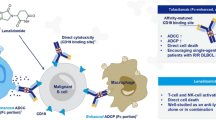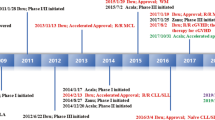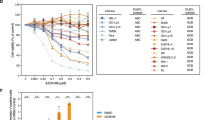Abstract
Diffuse large B-cell lymphoma (DLBCL) is the most common type of non-Hodgkin lymphoma. Although some patients can be cured by current therapies, novel agents are needed to further improve outcomes. We hypothesized that Src tyrosine kinase inhibition by dasatinib may have antilymphoma effects. Here, we demonstrate that dasatinib inhibits cell growth through G1-S blockage in five of seven DLBCL cell lines at clinically achievable concentrations. Compared to resting B cells, DLBCL has increased tyrosine phosphorylation activities. As expected, dasatinib inhibits phosphorylation of several Src family kinase members. However, this inhibition occurs in all cell lines regardless of their proliferative response to the drug. In contrast, the activity of two downstream signaling molecules, Syk and phospholipase Cγ2 (PLCγ2), are well correlated with cell line sensitivity to dasatinib, suggesting that these molecules are crucial in mediating the proliferation of activated lymphoma cells. Furthermore, dasatinib inhibits B-cell receptor signaling in primary lymphoma cells. Together, our findings not only show dasatinib as a potentially useful therapy for DLBCL but also provide insights into the pathogenesis of the lymphoma. The results further suggest the possibility of using Syk and PLCγ2 as biomarkers to predict dasatinib therapeutic response in prospective clinical trials.
This is a preview of subscription content, access via your institution
Access options
Subscribe to this journal
Receive 12 print issues and online access
$259.00 per year
only $21.58 per issue
Buy this article
- Purchase on Springer Link
- Instant access to full article PDF
Prices may be subject to local taxes which are calculated during checkout









Similar content being viewed by others
References
Sehn LH . Optimal use of prognostic factors in non-Hodgkin lymphoma. Hematology (Am Soc Hematol Educ Program) 2006, 295–302.
Andrew T, Lister BC, Armitage JO . Non-Hodgkin's lymphoma. In: Martin D. Abeloff, James O. Armitage JEN, Michael B. Kastan, W. Gillies McKenna (eds). Clinical Oncology. (e 3rd edn) Churchill Livingstone: Philadelphia PA, 2004, pp 3015–3076.
De Paepe P, De Wolf-Peeters C . Diffuse large B-cell lymphoma: a heterogeneous group of non-Hodgkin lymphomas comprising several distinct clinicopathological entities. Leukemia 2007; 21: 37–43.
Abramson JS, Shipp MA . Advances in the biology and therapy of diffuse large B-cell lymphoma: moving toward a molecularly targeted approach. Blood 2005; 106: 1164–1174.
Coiffier B . Rituximab therapy in malignant lymphoma. Oncogene 2007; 26: 3603–3613.
Kuppers R . Mechanisms of B-cell lymphoma pathogenesis. Nat Rev Cancer 2005; 5: 251–262.
Rodriguez A, Villuendas R, Yanez L, Gomez ME, Diaz R, Pollan M et al. Molecular heterogeneity in chronic lymphocytic leukemia is dependent on BCR signaling: clinical correlation. Leukemia 2007; 21: 1984–1991.
Dal Porto JM, Gauld SB, Merrell KT, Mills D, Pugh-Bernard AE, Cambier J . B cell antigen receptor signaling 101. Mol Immunol 2004; 41: 599–613.
Alizadeh AA, Eisen MB, Davis RE, Ma C, Lossos IS, Rosenwald A et al. Distinct types of diffuse large B-cell lymphoma identified by gene expression profiling. Nature 2000; 403: 503–511.
Rosenwald A, Wright G, Chan WC, Connors JM, Campo E, Fisher RI et al. The use of molecular profiling to predict survival after chemotherapy for diffuse large-B-cell lymphoma. N Engl J Med 2002; 346: 1937–1947.
Wright G, Tan B, Rosenwald A, Hurt EH, Wiestner A, Staudt LM . A gene expression-based method to diagnose clinically distinct subgroups of diffuse large B cell lymphoma. Proc Natl Acad Sci USA 2003; 100: 9991–9996.
Monti S, Savage KJ, Kutok JL, Feuerhake F, Kurtin P, Mihm M et al. Molecular profiling of diffuse large B-cell lymphoma identifies robust subtypes including one characterized by host inflammatory response. Blood 2005; 105: 1851–1861.
Shipp MA, Ross KN, Tamayo P, Weng AP, Kutok JL, Aguiar RC et al. Diffuse large B-cell lymphoma outcome prediction by gene-expression profiling and supervised machine learning. Nat Med 2002; 8: 68–74.
Wang YL, Frauwirth KA, Rangwala SM, Lazar MA, Thompson CB . Thiazolidinedione activation of peroxisome proliferator-activated receptor gamma can enhance mitochondrial potential and promote cell survival. J Biol Chem 2002; 277: 31781–31788.
Anagostopoulos I, Dallenbach F, Stein H . Diffuse large cell lymphomas. In: Knowles DM (ed). Neoplastic Hematopathology, 2nd edn, Lippincott Williams &Wilkins: Philadelphia, PA, 2001, pp 855–913.
Hans CP, Weisenburger DD, Greiner TC, Gascoyne RD, Delabie J, Ott G et al. Confirmation of the molecular classification of diffuse large B-cell lymphoma by immunohistochemistry using a tissue microarray. Blood 2004; 103: 275–282.
Chang CC, McClintock S, Cleveland RP, Trzpuc T, Vesole DH, Logan B et al. Immunohistochemical expression patterns of germinal center and activation B-cell markers correlate with prognosis in diffuse large B-cell lymphoma. Am J Surg Pathol 2004; 28: 464–470.
Haarer CF, Roberts RA, Frutiger YM, Grogan TM, Rimsza LM . Immunohistochemical classification of de novo, transformed, and relapsed diffuse large B-cell lymphoma into germinal center B-cell and nongerminal center B-cell subtypes correlates with gene expression profile and patient survival. Arch Pathol Lab Med 2006; 130: 1819–1824.
Salazar EP, Rozengurt E . Src family kinases are required for integrin-mediated but not for G protein-coupled receptor stimulation of focal adhesion kinase autophosphorylation at Tyr-397. J Biol Chem 2001; 276: 17788–17795.
Contri A, Brunati AM, Trentin L, Cabrelle A, Miorin M, Cesaro L et al. Chronic lymphocytic leukemia B cells contain anomalous Lyn tyrosine kinase, a putative contribution to defective apoptosis. J Clin Invest 2005; 115: 369–378.
Spreafico A SS, Serchi T, Orlandini M, Angelucci A, Magrini D, Bernardini G et al. Antiproliferative and proapoptotic activities of new pyrazolo[3,4-d]p yrimidine derivative Src kinase inhibitors in human osteosarcoma cells. FASEB J 2008 2008; 22: 1560–1571.
Nunoda K, Tauchi T, Takaku T, Okabe S, Akahane D, Sashida G et al. Identification and functional signature of genes regulated by structurally different ABL kinase inhibitors. Oncogene 2007; 26: 4179–4188.
Muris JJ, Cillessen SA, Vos W, van Houdt IS, Kummer JA, van Krieken JH et al. Immunohistochemical profiling of caspase signaling pathways predicts clinical response to chemotherapy in primary nodal diffuse large B-cell lymphomas. Blood 2005; 105: 2916–2923.
Muris JJ, Meijer CJ, Vos W, van Krieken JH, Jiwa NM, Ossenkoppele GJ et al. Immunohistochemical profiling based on Bcl-2, CD10 and MUM1 expression improves risk stratification in patients with primary nodal diffuse large B cell lymphoma. J Pathol 2006; 208: 714–723.
Duckett CS, Nava VE, Gedrich RW, Clem RJ, Van Dongen JL, Gilfillan MC et al. A conserved family of cellular genes related to the baculovirus iap gene and encoding apoptosis inhibitors. EMBO J 1996; 15: 2685–2694.
Liston P, Roy N, Tamai K, Lefebvre C, Baird S, Cherton-Horvat G et al. Suppression of apoptosis in mammalian cells by NAIP and a related family of IAP genes. Nature 1996; 379: 349–353.
Irish JM, Czerwinski DK, Nolan GP, Levy R . Kinetics of B cell receptor signaling in human B cell subsets mapped by phosphospecific flow cytometry. J Immunol 2006; 177: 1581–1589.
Johnson FM, Saigal B, Talpaz M, Donato NJ . Dasatinib (BMS-354825) tyrosine kinase inhibitor suppresses invasion and induces cell cycle arrest and apoptosis of head and neck squamous cell carcinoma and non-small cell lung cancer cells. Clin Cancer Res 2005; 11: 6924–6932.
Schittenhelm MM, Shiraga S, Schroeder A, Corbin AS, Griffith D, Lee FY et al. Dasatinib (BMS-354825), a dual SRC/ABL kinase inhibitor, inhibits the kinase activity of wild-type, juxtamembrane, and activation loop mutant KIT isoforms associated with human malignancies. Cancer Res 2006; 66: 473–481.
Serrels A, Macpherson IR, Evans TR, Lee FY, Clark EA, Sansom OJ et al. Identification of potential biomarkers for measuring inhibition of Src kinase activity in colon cancer cells following treatment with dasatinib. Mol Cancer Ther 2006; 5: 3014–3022.
Tsao AS, He D, Saigal B, Liu S, Lee JJ, Bakkannagari S et al. Inhibition of c-Src expression and activation in malignant pleural mesothelioma tissues leads to apoptosis, cell cycle arrest, and decreased migration and invasion. Mol Cancer Ther 2007; 6: 1962–1972.
Finn RS, Dering J, Ginther C, Wilson CA, Glaspy P, Tchekmedyian N et al. Dasatinib, an orally active small molecule inhibitor of both the src and abl kinases, selectively inhibits growth of basal-type/‘triple-negative’ breast cancer cell lines growing in vitro . Breast Cancer Res Treat 2007; 105: 319–326.
Quintas-Cardama A, Kantarjian H, O’Brien S, Borthakur G, Bruzzi J, Munden R et al. Pleural effusion in patients with chronic myelogenous leukemia treated with dasatinib after imatinib failure. J Clin Oncol 2007; 25: 3908–3914.
Carter TA, Wodicka LM, Shah NP, Velasco AM, Fabian MA, Treiber DK et al. Inhibition of drug-resistant mutants of ABL, KIT, and EGF receptor kinases. Proc Natl Acad Sci USA 2005; 102: 11011–11016.
Sprangers M, Feldhahn N, Herzog S, Hansmann ML, Reppel M, Hescheler J et al. The SRC family kinase LYN redirects B cell receptor signaling in human SLP65-deficient B cell lymphoma cells. Oncogene 2006; 25: 5056–5062.
Author information
Authors and Affiliations
Corresponding author
Additional information
Supplementary Information accompanies the paper on the Leukemia website (http://www.nature.com/leu)
Supplementary information
Rights and permissions
About this article
Cite this article
Yang, C., Lu, P., Lee, F. et al. Tyrosine kinase inhibition in diffuse large B-cell lymphoma: molecular basis for antitumor activity and drug resistance of dasatinib. Leukemia 22, 1755–1766 (2008). https://doi.org/10.1038/leu.2008.163
Received:
Revised:
Accepted:
Published:
Issue Date:
DOI: https://doi.org/10.1038/leu.2008.163
Keywords
This article is cited by
-
Dasatinib reverses drug resistance by downregulating MDR1 and Survivin in Burkitt lymphoma cells
BMC Complementary Medicine and Therapies (2020)
-
New roles for B cell receptor associated kinases: when the B cell is not the target
Leukemia (2019)
-
Fbw7 regulates apoptosis in activated B-cell like diffuse large B-cell lymphoma by targeting Stat3 for ubiquitylation and degradation
Journal of Experimental & Clinical Cancer Research (2017)
-
HSP90 stabilizes B-cell receptor kinases in a multi-client interactome: PU-H71 induces CLL apoptosis in a cytoprotective microenvironment
Oncogene (2017)
-
Functional characterization of BTKC481S mutation that confers ibrutinib resistance: exploration of alternative kinase inhibitors
Leukemia (2015)



